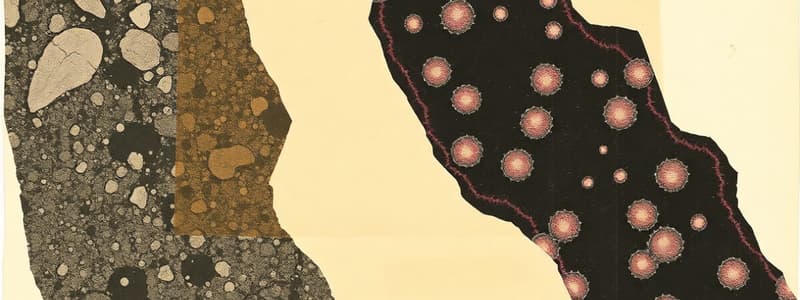Podcast
Questions and Answers
Which type of microscope uses a beam of accelerated electrons for illumination?
Which type of microscope uses a beam of accelerated electrons for illumination?
- Light microscope
- Electron microscope (correct)
- Fluorescent microscope
- Atomic force microscope
Light microscopes can magnify objects to more than 1,000 times their actual size.
Light microscopes can magnify objects to more than 1,000 times their actual size.
True (A)
What is the most common method for tissue preparation in light microscopy?
What is the most common method for tissue preparation in light microscopy?
Sectioning
The ______ microscope is the first type of microscope invented.
The ______ microscope is the first type of microscope invented.
Match the following tissue preparation methods with their descriptions:
Match the following tissue preparation methods with their descriptions:
What is the purpose of staining in tissue preparation?
What is the purpose of staining in tissue preparation?
Electron microscopes have a lower resolving power compared to light microscopes.
Electron microscopes have a lower resolving power compared to light microscopes.
Name the part of a light microscope used for focusing the image.
Name the part of a light microscope used for focusing the image.
Flashcards
What is Histology?
What is Histology?
The study of the microscopic structure of normal cells, tissues, and organs.
What is a microscope?
What is a microscope?
A device used to magnify small objects, making them visible to the naked eye.
What is a light microscope?
What is a light microscope?
The most common type of microscope, using light to pass through a sample, creating an image.
What is an electron microscope?
What is an electron microscope?
Signup and view all the flashcards
What is tissue sectioning?
What is tissue sectioning?
Signup and view all the flashcards
What is Filming?
What is Filming?
Signup and view all the flashcards
What is Teasing or Squeezing?
What is Teasing or Squeezing?
Signup and view all the flashcards
What is Stretching?
What is Stretching?
Signup and view all the flashcards
Study Notes
Histology Practical - Microscope 2024
- Histology is the microscopic study of normal cells, tissues, and organs. Examination involves sectioning, staining, and viewing under a microscope.
Introduction
- Microscopes magnify small objects, allowing observation by the naked eye.
- Most microscopes use powerful lenses to enlarge specimens over 100 times their actual size.
- Microscopes are expensive, so proper handling is crucial.
Types of Microscopes
- Light (optical) microscopes use light to pass through a sample and create an image.
- Electron microscopes use beams of accelerated electrons for higher resolution viewing, revealing structures smaller than those visible with light microscopes. They have two types : transmission electron microscopy (TEM) and scanning electron microscopy (SEM).
Parts of a Light Microscope
- Body tube: Includes the ocular (eyepiece) and revolving nosepiece with objective lenses.
- Arm: Used for carrying the microscope. It supports the rest of the microscope and has controls for coarse and fine focus adjustment.
- Stage: Supports the microscope slide holding the specimen; often has clips to hold the slide in place.
- Light source: Provides the light for viewing the specimen. Light should be mild to moderate.
- Condenser: Focuses and controls the light intensity directed onto the specimen.
Microscopy Diagram Labeling
- Key components of the light microscope, like stage clips, revolving nosepiece, ocular lens, arm, light source, body tube, base, and objective lenses are labeled on a diagram.
Electron Microscope
- Uses a beam of accelerated electrons as illumination.
- The short wavelength of electrons produces a higher resolving power than light microscopes.
- Enables examination of the structure of smaller objects.
Comparison Between Light & Electron Microscopes
- Light Microscope (LM): Uses visible light (often electric or transmitted daylight); non-vacuumed tube; view using glass lenses; magnification up to 1000 times & resolution around 0.2 µm; observations can be made by human eyes.
- Electron Microscope (EM): Uses invisible electron beam; vacuumed tube; magnification up to 100,000 times or more; resolution is around 0.003 micrometers (nm); view using electromagnetic coils; observations view by Fluorescent screen.
Tissue Preparation for Light Microscopy
- Several methods prepare specimens for microscopic examination:
- Filming: Tissue fluids (e.g., blood films).
- Teasing/Squeezing: Tissue structures such as muscle and nerves.
- Stretching: Elastic tissue (e.g., fascia, membranes).
- Sectioning/Cutting: The most common method, involves thin sections using a microtome (instrument for cutting slices). Often employing paraffin techniques.
Preparation of Paraffin Sections
- Obtaining the tissue: Must be fresh, with minimal thickness (less than 60 cm³) for good fixation.
- Fixation: Preserves the tissue in a life-like state to prevent postmortem changes (e.g., decomposition).
- Functions of Fixation:
- Keeps proteins stable.
- Prevents postmortem changes.
- Reduces shrinkage and distortion.
- Improves stainability by altering refractive indices.
- Fixatives: Common fixatives include 10% formalin or formal saline, Bouin's solution, osmic acid, glutaraldehyde, and combinations of alcohols.
- Wash excess fixative: Removing excess fixative reagent by running water or alcohol solutions.
- Dehydration: Gradually removing water from tissue using increasing concentrations of ethyl alcohol (e.g., 70%, 90%, 95%, 100%). This prevents shrinkage.
- Time needed for dehydration: Based on tissue thickness (<60 cm³), it takes 2-3 hours, and changes are done hourly, while absolute alcohol requires 1-1 hour each. The concentration of dehydrating agent should be around 10 times that of the tissue
- Dehydration effects: Over-dehydration leads to tissue hardening and a cloudy appearance. Incomplete dehydration results in tissue containing water and cracking.
- Clearing: Replacing alcohol with a solvent (e.g., xylol, methylbenzoate) that is miscible with paraffin. This makes the tissue ready for paraffin infiltration.
- Impregnation: Immerse the cleared tissue in melted paraffin to infiltrate and support the tissue. The process typically uses different paraffin baths and takes 1-2 hours per stage.
- Embedding: Embedding the tissue in paraffin to create a solid block for sectioning. Utilizing a paper or special metal molds.
- Frozen section: A method for preparing fresh, unfixed tissue for sections, often used in histochemical methods.
Precautions During Paraffin Section Preparation
- Handle specimens gently.
- Use an appropriate preparation schedule.
- Use high-quality paraffin wax.
- Avoid cross-contamination between tissue sections.
Staining
- Stain: A soluble coloring agent penetrating and retaining inside the tissue.
- Functions of stains:
- Provides clearer observation and analysis of cells.
- Identifies cell abnormalities.
- Changes cell and tissue color significantly.
- Types of stains:
- General stains: (e.g., hematoxylin and eosin, H&E).
- Special stains: Reveal specific tissue components (e.g., Sudan black stains lipids).
- Histochemical and cytochemical stains: Identify specific chemical components (e.g., PAS reaction for carbohydrates).
Steps of Staining Paraffin Sections using H&E Stain
- Deparaffinization (xylol): Removing paraffin.
- Hydration (alcohol): Returning to aqueous solutions.
- Staining (hematoxylin): Staining nuclei.
- Washing (running water): Removing excess stain.
- Counterstaining (eosin): Staining cytoplasm.
- Mounting (with a coverslip and mounting medium): Protecting the slide for examination.
Affinity to General Stain
- Basophilic: Acidic cell components (e.g., nucleus) have an affinity towards basic stains.
- Acidophilic: Basic cell components (e.g., cytoplasm) have an affinity towards acidic stains.
- Neutralophilic: Some components have affinity towards both acidic and basic stains.
Staining Methods & Alcohol Concentration
- Various alcohol concentrations are used during tissue preparation to prevent shrinkage and maintain tissue integrity during staining.
Steps of preparing paraffin sections
- A diagram summarizing the steps (fixation, dehydration, clearing, infiltration, embedding) in preparing a paraffin section.
Ground Preparation
- Technique for preparing thin sections of bone or tissue involving precise sawing, embedding in resin, grinding, and polishing.
Studying That Suits You
Use AI to generate personalized quizzes and flashcards to suit your learning preferences.




